Cambodia : Angkor Wat
Created | Updated Jun 21, 2003
Angkor Wat
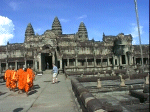
Angkor Wat is the largest of the temples at Angkor and dominates the scene. It is thought that it was built as a funerary temple for Suryavarma II, who ruled between 1112 and 1152.
Angkor Wat is the only of the temples of Angkor that was not reclaimed by the jungle after the Khmer court moved to Phnom Penh in the 15th century.
It was visited in the 16th century by Portuguese travellers and, in the 17th century a Japanese pilgrim drew a detailed plan (although he thought he was in India!). When Henri Mouhot 'discovered' Angkor Wat in the 1860's it was a prosperous monastery with over one thousand inhabitants.
Many things about Angkor Wat are unique; the most obvious being the fact that it faces to the west (the direction of death).
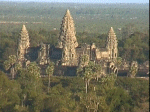
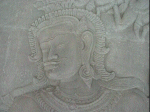
There are many subtle meanings to the layout of the temple. The central temple tower represents Mt. Meru with its surrounding peaks, while the lower courtyards are the continents and the moat the oceans.
The moat surrounding Angkor Wat is 190 metres wide and 5.6 kilometres around. There are two causeways leading to it; in the west one of sandstone, in the east one of earth. Within the moat is a rectangular walled enclosure, 102 metres by 800 metres.
The central temple complex is made up of three storeys, the corners of the second and third storeys each have a tower. While, at the centre of the third storey, is a 31 metre high central tower.
Like The Bayon, Angkor Wat is also famous for its bas reliefs. On the outside of the central temple complex is an esplanade with an 800 metre series of scenes. They range from depictions of actual battles, the mythological battles of the Gods, to, most famously, 'The Churning of the Ocean of Milk'.
Angkor Wat can get very busy, particularly towards sunset, the best time to see the temple. But, the complex is so large, it is still possible to find a corner with no-one else around.
Another way to see Angkor Wat, if you have a long lens and a tripod, is also at sunset, from the top of Phnom Bakheng
Phnom Bakheng
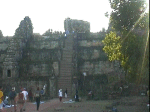
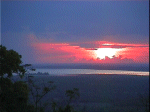
Phnom Bakheng is the site of the first of the temple mountains built in the Angkor area. At the top of the hill is a seven level temple made up of a base, a five level temple mountain, and the summit.
On the summit is a central sanctuary and four towers (one at each of the cardinal points).
The hill is 1.3 kilometres away from Angkor Wat, affording a different perspective on the temple.
That and the clear vista across the jungle to the Tonlé Sap Lake brings crowds to the summit as the sun is going down.
